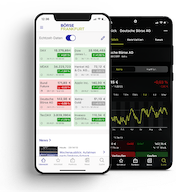Weekly outlook: Probable US interest rate cut in sight

There are still no signs of a breakout from the sideways trend. It's time to wait and see. On Wednesday, the US Federal Reserve will decide on the key interest rate – and according to firm expectations, it will now fall.
15 September 2025. FRANKFURT (Börse Frankfurt). While US markets continue to reach new heights, the DAX has been treading water for months. This trend is continuing at the start of the new week. On Monday morning, the DAX stood at 23,776 points, up from 23,698 at Friday's close. This means that the recent high remains a long way off. The Stoxx Europe 600 is also unable to build on its record highs. The S&P 500 and Nasdaq, on the other hand, reached new all-time highs again on Friday. The highlight of the week: the US Federal Reserve meeting on Wednesday. The ECB left key interest rates unchanged last Thursday, and the US Federal Reserve is now widely expected to cut interest rates.
Much of the uncertainty stems from geopolitical factors. “Unfortunately, we cannot expect this chaotic year to end on a calm note,” explains Ulf Krauss of Helaba. Rather, it seems as if new boundaries are being tested in a geopolitically tense environment. “Israel is attacking Hamas in Qatar and Russia is sending drones into Poland.” In the US, the murder of Trump supporter Charlie Kirk is likely to further deepen political divisions. Added to this is the difficult situation in France. On Friday evening, the rating agency Fitch downgraded France's rating from AA- to A+.
Strong profit growth expected for 2026
Looking beyond the short term, however, confidence in the stock market remains high: According to Andreas Hürkamp of Commerzbank, the DAX and Euro Stoxx 50 have been stuck in sideways trends since the beginning of April. “On the one hand, valuations are already quite high, and on the other hand, corporate profits are unlikely to increase in the 2025 financial year,” he explains. However, looking ahead to 2026, he expects profit growth of 6 to 8 percent. “We therefore recommend that investors continue to hold their positions in the DAX and Euro Stoxx 50 for the time being and gradually expand them again during periods of weakness.”
“Stocks offer greater security and returns than bonds in the long term”
According to Robert Halver of Baader Bank, stock markets are highly valued. “But if the business models are right, especially in high-tech, then they are also justified,” he says. Companies are making good profits. The tech boom is also boosting the overall market. “Services, manufacturing, and infrastructure, i.e., the virtual and physical worlds, will form a symbiosis,” explains Halver. Last but not least, the interest rate market has lost its importance as a safe haven, he adds, referring to the recent turmoil. “From a traditional portfolio perspective, it sounds absurd. But stocks bring more security and returns to the investment portfolio in the long term.”
“Breakout from trend not until early October”
Chart technician Christoph Geyer points out that the DAX has held up quite well so far in the difficult month of September. “However, this stable performance does not protect against another period of turbulence before the year-end rally begins in October,” warns Geyer. The indicators, which are trading in oversold territory, have contributed to the stable performance, but may not be able to offer much support now. “The DAX is in a sideways range. A breakout from this range is likely to represent the new trend,” he explains. According to statistics, this should be upward, but is unlikely to begin before early October.
Important economic and financial data
Monday, September 15
Japan: Stock market closed for public holiday
4:00 a.m. China: Retail sales/industrial production for August.
Tuesday, September 16
11:00 a.m. Germany: ZEW economic expectations for September. DekaBank believes that US tariff policy and Germany's tentative economic policy are likely to continue to dampen sentiment in the ZEW survey.
2:30 p.m. USA: Retail sales for August. According to Commerzbank, retail sales in the USA are likely to have risen further in August, even though the downturn in the labor market is likely to weigh on consumer sentiment.
Wednesday, September 17
8:00 p.m. USA: Interest rate decision by the US Federal Reserve. Following the latest US inflation data, US investment company Pimco has not changed either its Fed forecast or its inflation outlook. “We still expect the Fed to cut interest rates by 25 basis points, even though 50 basis points is likely to be discussed,” explains Pimco economist Tiffany Wilding. Overall, Pimco expects interest rate cuts of 75 basis points this year.
Thursday, September 18
11:00 a.m. United Kingdom: Bank of England interest rate decision. A year ago, inflation in the United Kingdom was within the monetary policy target range of 2 percent, as DekaBank notes, but it has risen since then. Inflation recently reached 3.8 percent, where it is likely to remain in August. Following the key interest rate cut to 4 percent last month, no change in the key interest rate is expected in this interest rate decision.
Friday, September 19
Major expiration date for options and futures. Futures and options contracts are expiring on global futures exchanges. This day may therefore see high trading volumes and sharp fluctuations in securities prices.
Japan: Interest rate decision by the Bank of Japan. According to Deutsche Bank's assessment, the Bank of Japan will initially maintain its wait-and-see stance and leave the key interest rate at 0.5 percent – partly due to the still unresolved succession of the resigned Prime Minister Shigeru Ishiba.
By Anna-Maria Borse, 15 September 2025, © Deutsche Börse AG
About the Author
Anna-Maria Borse is a finance and economics editor specializing in financial markets/stock exchanges and economic issues.
Feedback and questions to redaktion@deutsche-boerse.com





